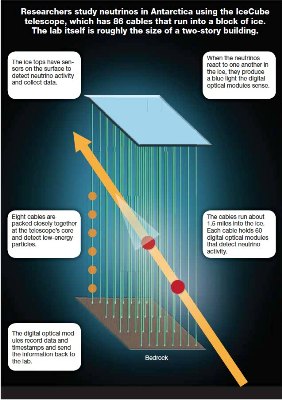Dec 4 2013
After years of self-motivated particle and astrophysical research with IceCube, a neutrino-detecting telescope sealed in the ice of Antartica, researchers recently confirmed evidence of 28 events involving high-energy neutrinos from outside the galaxy.
 CW | Hannah Glenn, Information obtained from MCT Campus
CW | Hannah Glenn, Information obtained from MCT Campus
More than 250 researchers from more than 40 universities in countries all over the world, including from The University of Alabama, contributed to the IceCube Collaboration’s report published in Science magazine Nov. 22. The report received attention from newspapers across the country after it revealed the most recent data about high energy neutrinos from outside the galaxy.
“We have the first detection of high energy neutrinos from out of the galaxy,” said Dawn Williams, UA IceCube calibrator and associate professor of physics.
A neutrino is a neutral, massless subatomic particle that does not react with matter. Though billions of low energy neutrinos originating from the sun and Earth’s atmosphere pass through Earth daily, the sources of the recently-found high energy neutrinos are still unknown.
“The ultimate goal is to find where these things are coming from,” Williams said.
Since the 1980s, the idea to study high energy neutrinos has been kicked around by particle researchers. After a successful experiment in the 1990s officially proved that they could detect extremely high energy neutrinos, the IceCube Collaboration built the IceCube Neutrino Observatory in Antartica. Digital optical modules and embedded strings were drilled deep into the ice in spring 2010.
The IceCube Collaboration, headquartered in Madison, Wis., seeks to measure the rate of high energy neutrinos and analyze data obtained from the IceCube detector in Antartica. Williams began her IceCube research in 2004. When she was hired at The University of Alabama in 2008, she continued her research and started a small group composed of UA undergraduates, graduates and professors.
“It’s been a lot of running computer programs, making graphs and analyzing data,” said Jacob Morrison, a junior majoring in physics and independent study research intern with IceCube.
In spring 2011, some of the IceCube graduate students from the University got to go to the South Pole and check out the neutrino sensors and ensure they were properly working.
“It was absolutely very exciting to see the powerful computer farms in the most remote place,” said Donglian Xu, a sixth-year graduate student who has worked with IceCube since 2009.
Since ice is transparent and a natural support structure, it was the best reduced cost environment for the research. The South Pole was chosen because the ice there is clean and located above a continent, not an ocean, so it won’t disappear over time. A U.S. research base with living quarters has been occupied there for more than 50 years, so it is a suitable place for IceCube researchers to work.
At the University, most of the research involves computing and data analysis. When they went to the South Pole, Xu said their mission involved checking the controls of 5,000 sensors. This ensured the data they were collecting on the high energy neutrinos was correct.
Although the source of the neutrinos detected by IceCube has yet to be identified, they could eventually provide a connection to galaxies far away from Earth.
“This is basically opening up a new window into outer space,” Xu said.
The current study is purely for scientific purposes. Williams said once researchers find more about where neutrinos from outside the galaxy originate from, they could gain further insight on the energy spectrum. They will need more than the current 28 events to determine this, and the UA team plans to keep working with IceCube.
“I’m very happy with what we have been able to accomplish at UA with the amount of people we have working on this,” Williams said.